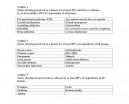(Press-News.org) DOHA, QATAR (2 December 2012)_Forestry experts have called for a new approach to managing land and tackling climate change – challenging the ongoing debate that forests have to be sacrificed for the sake of rural development and food security.
Governments, policymakers and scientists worldwide have been experimenting for years with different approaches to managing rural landscapes, from watershed management to habitat restoration, but these efforts are rarely done in concert to address climate change challenges.
"It is time to look at new ways of solving old problems," said Peter Holmgren, Director General of the Centre for International Forestry Research (CIFOR) in a keynote speech at Forest Day 6, a daylong event held on the sidelines of the United Nations climate talks in Doha.
"Climate change needs to be dealt with across sector boundaries. Forests and forestry must be looked at through the lenses of agriculture, food security and broader sustainable development. It is time for forestry to come out of the forest and contribute more broadly."
Andreas Tveteraas, Senior Adviser to Norway's International Climate and Forest Initiative, supported this view: "The challenge is to do both forest conservation and increased food production [and not at] the expense of forests. No doubt if a government has to choose between them, then the forests will always lose, so the challenge is to promote forest management in a way that goes hand in hand with feeding the population."
A landscape-based approach, which looks at the synergies and trade-offs of managing a broad resource mix, has been hailed as a new way to bring together the agricultural, forestry, energy and fishery sectors to better manage the world's resources while offering opportunities for climate adaptation and mitigation.
"The window to stay in a two-degree world is closing very rapidly," said Mary Barton-Dock, Director of Climate Policy and Finance at the World Bank.
And in the context of a changing climate, she added, "A landscape approach is going to be essential to meet the growing need for food without invading forests."
"Food security challenges are not something of the future," said Deborah Bossio, Soils Research Area Director at the International Center for Tropical Agriculture (CIAT).
"We are moving beyond the era where land is plentiful and are now faced with increasing land scarcity. Forest conservation can contribute and be a part of climate-smart agriculture."
Nearly 4 billion hectares of forests cover the earth's surface, roughly 30 percent of total land area. Yet the world is in the grip of huge changes that are redefining pressures on forests, including urbanisation, increasingly meat-based diets, population growth and a booming demand for timber and agricultural products.
"Everything you thought you knew about deforestation in the 20th century is no longer true," said Doug Boucher, Director of Climate Research and Analysis at the Union of Concerned Scientists.
"Population growth has decreased all around the world in rural areas, yet we are seeing massive urbanisation and the growth of urbanised industries interacting with each other… so we have to be alert to emerging drivers."
Keeping forest people's livelihoods on the climate change agenda
Wu Hongbo, United Nations Under-Secretary-General for Economic and Social Affairs, highlighted invisible income forests provide to rural livelihoods.
"Formal cash contributions of forests to developing economies are at US$326 billion. This is more than twice the size of total official development assistance (ODA) flows."
Ephraim Kamuntu, Minister for Water and the Environment in Uganda, highlighted the need to ensure that rural livelihoods are tackled as part of the climate change agenda.
"The challenges we are talking about tie intrinsically in with the eradication of poverty in our countries."
Forests play an essential role within this broad approach of addressing conservation, rural livelihoods, biodiversity and food security, said Barton-Dock.
"Trees are really still our heroes in that they are working across our needs for water, our need for carbon and for the needs of local people. Moving towards landscapes will help us move towards sustainability."
Today's event marks the first occasion that Forest Day broadens its agenda through the combined consideration of agriculture, forestry and land use, and their impacts on society. Forest Day is being held in conjunction with Agriculture, Landscapes and Livelihoods Day, under the theme of "Living Landscapes", with both events exploring the synergies, complementarities and trade-offs of landscapes to offer sustainable solutions for climate change adaptation and mitigation as well as improved livelihoods.
###
MEDIA RESOURCES
Media are invited to use online resources from the event:
Event photos:
http://www.flickr.com/photos/cifor/sets/72157632151195034/
Video Webcasting:
http://www.forestday.org/live
Blog:
http://www.blog.cifor.org/cop18
Twitter:
@cifor_forests (Event hashtag: #ALLForest)
FOR MORE INFORMATION
Forest Day is convened by the Center for International Forestry Research on behalf of the Collaborative Partnership on Forests. Forest Day is the first of two popular conferences on the sidelines of the United Nations Framework Convention on Climate Change's (UNFCCC) annual Conference of the Parties. Forest Day 6 will be followed by Agriculture, Landscapes and Livelihoods Day 5 slated for December 3 at the same venue – both with the banner of "Living Landscapes", which refers to the interconnections between forests and agriculture and their impacts on people and society. For more information, visit www.ForestDay.org
The Collaborative Partnership on Forests (CPF) is a voluntary arrangement among 14 international organisations and secretariats with substantial programmes on forests (CIFOR, FAO, ITTO, IUFRO, CBD, GEF, UNCCD, UNFF, UNFCCC, UNDP, UNEP, ICRAF, WB and IUCN). The CPF's mission is to promote the management, conservation and sustainable development of all types of forest and strengthen long-term political commitment to this end.
The Center for International Forestry Research (CIFOR) advances human wellbeing, environmental conservation and equity by conducting research to inform policies and practices that affect forests in developing countries. CIFOR helps ensure that decision-making that affects forests is based on solid science and principles of good governance, and reflects the perspectives of developing countries and forest-dependent people. CIFOR is one of 15 centres within the Consultative Group on International Agricultural Research.
'Come out of the forest' to save the trees
2012-12-03
ELSE PRESS RELEASES FROM THIS DATE:
JCI early table of contents for Dec. 3, 2012
2012-12-03
Lithium restores cognitive function in Down syndrome mice
Down syndrome is a neurodevelopmental disorder that is the leading cause of genetically defined intellectual disability. In the brain, Down syndrome results in alterations in the connections between neurons and a reduction in the development of new neurons (neurogenesis) that usually occurs during learning. In this issue of the Journal of Clinical Investigation, researchers led by Laura Gasparini at the Istituto Italiano di Tecnologia in Genova, Italy report that lithium, a drug commonly used for the treatment ...
Lithium restores cognitive function in Down syndrome mice
2012-12-03
Down syndrome is a neurodevelopmental disorder that is the leading cause of genetically defined intellectual disability. In the brain, Down syndrome results in alterations in the connections between neurons and a reduction in the development of new neurons (neurogenesis) that usually occurs during learning. In this issue of the Journal of Clinical Investigation, researchers led by Laura Gasparini at the Istituto Italiano di Tecnologia in Genova, Italy report that lithium, a drug commonly used for the treatment of mood disorders in humans, restores neurogenesis in the hippocampus, ...
Stem cell-derived dopaminergic neurons rescue motor defects in Parkinsonian monkeys
2012-12-03
Parkinson's disease is a degenerative disorder of the central nervous system that is characterized by tremors, rigidity, slowness of movement, and difficulty walking. It is caused by loss of the neurons that produce the neurotransmitter dopamine (known as dopaminergic neurons). One of the primary goals in Parkinson's disease research is to develop a replacement for dopaminergic neurons. In this issue of the Journal of Clinical Investigation, researchers led by Takuya Hayashi at the RIKEN Center for Molecular Imaging Science in Kobe, Japan, derived dopaminergic neurons from ...
Pygmy mole crickets don't just walk on water, they jump on it
2012-12-03
VIDEO:
Pygmy mole crickets are known to be prodigious jumpers on land. Now, researchers reporting in the Dec. 4 issue of Current Biology, a Cell Press publication, have found that the...
Click here for more information.
Pygmy mole crickets are known to be prodigious jumpers on land. Now, researchers reporting in the December 4th issue of Current Biology, a Cell Press publication, have found that the tiny insects have found an ingenious method to jump from the water, too. ...
Rules limiting aggression should reduce hockey injuries
2012-12-03
Instituting and enforcing rules that limit aggressive acts like bodychecking in ice hockey should help reduce injuries for young players, including serious brain and spine injuries, according to a new study published in CMAJ (Canadian Medical Association Journal).
"We found that interventions based on rule changes showed the greatest likelihood of making ice hockey safer for youth," writes Dr. Michael Cusimano, Division of Neurosurgery and the Injury Prevention Research Office, St. Michael's Hospital and the University of Toronto, Toronto, Ontario, with coauthors.
Brain ...
Risk of blood clots 2-fold for women with polycystic ovary syndrome on combined pill
2012-12-03
Women with polycystic ovary syndrome (PCOS) who are taking combined oral contraceptives have a 2-fold risk of blood clots compared with women without the disorder who take contraceptives, states a study published in CMAJ (Canadian Medical Association Journal).
PCOS affects between 6% and 10% of women of reproductive age with some estimates as high as 15%, making it the most common endocrine disorder in this age group. Risk factors for heart disease such as hypertension, diabetes, obesity and others are double among women with PCOS compared with women without the disorder. ...
Clinical trial hits new target in war on breast cancer
2012-12-03
Breast cancers are defined by their drivers – estrogen and progesterone receptors (ER and PR) and HER2 are the most common, and there are drugs targeting each. When breast cancer has an unknown driver, it also has fewer treatment options – this aggressive form of breast cancer without ER, PR or HER2, which was thought not to be driven by hormones, is known as triple negative. A decade ago, work at the University of Colorado Cancer Center added another potential driver to the list – the androgen receptor – and this week marks a major milestone in a clinical trial targeting ...
'Junk DNA' drives embryonic development
2012-12-03
LA JOLLA, Calif., December 3, 2012 – An embryo is an amazing thing. From just one initial cell, an entire living, breathing body emerges, full of working cells and organs. It comes as no surprise that embryonic development is a very carefully orchestrated process—everything has to fall into the right place at the right time. Developmental and cell biologists study this very thing, unraveling the molecular cues that determine how we become human.
"One of the first, and arguably most important, steps in development is the allocation of cells into three germ layers—ectoderm, ...
Grief is not a disease, but cancer is -- what about erectile dysfunction?
2012-12-03
"Understanding peoples' attitudes about whether states of being should be considered diseases can inform social discourse regarding a number of contentious social and health public policy issues," says Kari Tikkinen, MD, PhD, corresponding author of the FIND Survey.
All Finns think that myocardial infarction, breast cancer, malaria and pneumonia are diseases. People are equally unanimous that wrinkles, grief and homosexuality are not diseases. What about drug addiction or absence of sexual desire? Or erectile dysfunction, infertility or obesity?
"The word disease ...
Researchers confirm the 'Pinocchio Effect': When you lie, your nose temperature raises
2012-12-03
The University of Granada researchers are pioneers in the application of thermography to the field Psychology. Thermography is a technique based on determining body temperature.
When a person lies they suffer a "Pinocchio effect", which is an increase in the temperature around the nose and in the orbital muscle in the inner corner of the eye. In addition, when we perform a considerable mental effort our face temperature drops and when we have an anxiety attack our face temperature raises. These are some of the conclusions drawn in this pioneer study conducted at the University ...



